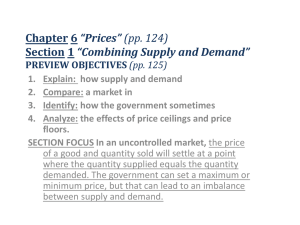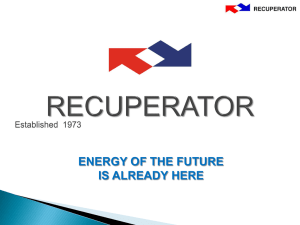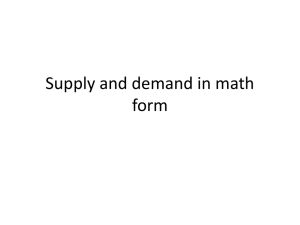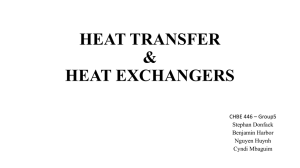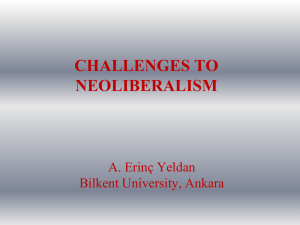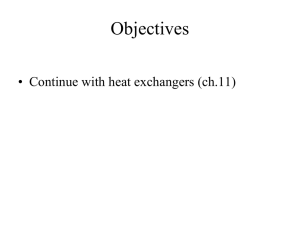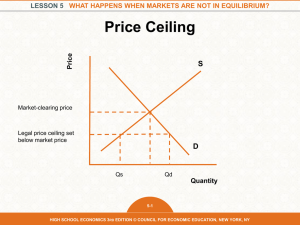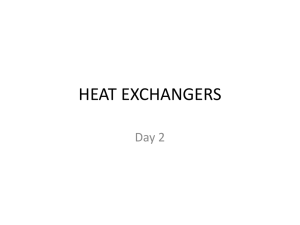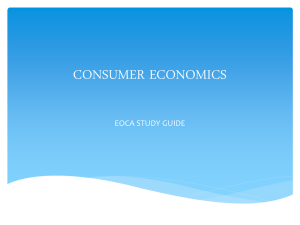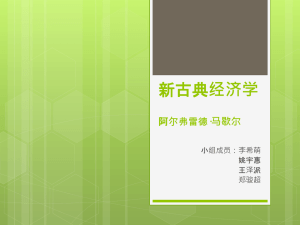PPT - Auburn University
advertisement
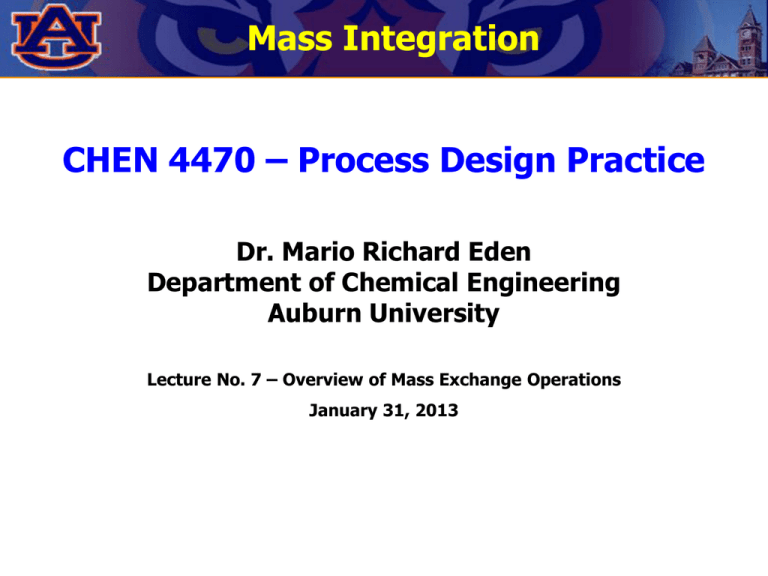
Mass Integration CHEN 4470 – Process Design Practice Dr. Mario Richard Eden Department of Chemical Engineering Auburn University Lecture No. 7 – Overview of Mass Exchange Operations January 31, 2013 What is a Mass Exchanger? • Mass Exchanger – A mass exchanger is any direct-contact mass-transfer unit which employs a Mass Separating Agent (or a lean phase) to selectively remove certain components (e.g. pollutants) from a rich phase (e.g. a waste stream). – Absorption, Adsorption, Extraction, Ion Exchange, …. R ic h (W a s te ) S tre a m F lo w ra te :G i In le t C o m p o s itio n : y i in O u tle t C o m p o s itio n : y i o u t M ass Exchanger L e a n S tre a m (M S A ) F lo w ra te :L j In le t C o m p o s itio n : x j in O u tle t C o m p o s itio n : x j o u t Equilibrium 1:4 • Generalized Description – The composition of the rich stream (yi) is a function of the composition of the lean phase (xj) yi f j ( x j ) * • * Dilute Systems – For some applications the equilibrium functions may be linearized over the operating range yi m j x j b j * Equilibrium 2:4 • Special Cases – Raoult’s law for absorption yi – p 0 solute (T ) PTotal xj * • Mole fraction of solute in gas • Vapor pressure of solute at T • Mole fraction of solute in liquid • Total pressure of gas Henry’s law for stripping yi H j x j * Hj PTotal p 0 solute (T ) y solubility i • Mole fraction of solute in gas • Mole fraction of solute in liquid • Henry’s coefficient • (T ) Liquid-phase solubility of the pollutant at temperature T Equilibrium 3:4 • Special Cases – Distribution function used in solvent extraction yi K j x j * • • Solute composition in liquid • Solute composition in solvent • Distribution coefficient Interphase Mass Transfer – For linear equilibrium the pollutant composition in the lean phase in equilibrium with yi can be calculated as: x * j yi b j mj Equilibrium 4:4 • Interphase Mass Transfer (Continued) – For linear equilibrium the pollutant composition in the rich phase in equilibrium with xj can be calculated as: yi m j x j b j * • Rate of Mass Transfer K y yi y * K x xj x j * i N pollutant • Overall mass transfer coefficient for rich phase • Overall mass transfer coefficient for lean phase Correlations for estimating overall mass transfer coefficients can be found in McCabe et al. (1993), Perry and Green (1984), King (1980) and Treybal (1980). Mass Exchangers – I • Multistage Contactors – Multistage countercurrent tray column L ig h t P h a s e O u t H e a v y P h a s e In W e ir D ow ncom er S h e ll P e rfo ra te d P la te (T ra y ) L ig h t P h a s e In H eavy Phase O ut 1:2 Mass Exchangers – I • 2:2 Multistage Contactors (Continued) – Multistage Mixer-Settler System MSA out W a s te in MSA in W a s te out Modeling – I • 1:5 Stagewise Columns – A generic mass exchanger R ic h (W a s te ) S tre a m F lo w ra te :G i In le t C o m p o s itio n : y i in O u tle t C o m p o s itio n : y i o u t M ass Exchanger O u tle t C o m p o s itio n : x j o u t L e a n S tre a m (M S A ) F lo w ra te :L j In le t C o m p o s itio n : x j in – Schematic of a multistage mass exchanger y i,1 = y i o u t y i,2 1 x j,0 = x j in y i,3 y i,n n 2 x j,1 y i,n + 1 y i,N -1 x j,2 x j,n .1 N N -1 x j,n x j,N -2 y i,N + 1 = y i in y i,N x j,N -1 x j,N = x j o u t Modeling – I • 2:5 Stagewise Columns (Continued) – Operating line (material balance) y ou t Gi yi yi in – out Lj xj xj out in L x in The McCabe-Thiele diagram y in O p e ra tin g L in e L j /G i y i in yi E q u ilib riu m L in e y io u t x j in xj x jo u t G x ou t Modeling – I • 3:5 Stagewise Columns (Continued) – The Kremser equation • • • Isothermal Dilute Linear equilibrium NTP m j Gi ln 1 Lj yiin m j x inj b j out in y m x bj j j i Lj ln m G j i m j Gi Lj Modeling – I • 4:5 Stagewise Columns (Continued) – Other forms of the Kremser equation NTP Lj ln 1 m j Gi m j Gi ln L j yi b j in out ,* xj ,* xiin x out j out out ,* x x j j Li m j Gi mj Lj in m j x j b j m j Gi y mjx in i out yi out j bj NTP Modeling – I • 5:5 Stagewise Columns (Continued) – Number of actual plates NAP – NTP o Stage efficiency can be based on either the rich or the lean phase. If based on the rich phase, the Kremser equation can be rewritten as: NTP m j Gi ln 1 Lj yiin m j x inj b j out in y m x bj j j i ln 1 y m j Gi L j m j Gi Lj 1 Mass Exchangers – II • Differential (Continuous) Contactors – Countercurrent packed column L ig h t Phase O ut H eavy P h a s e In P a c k in g R e s tra in e r Random P a c k in g S h e ll P a c k in g S u p p o rt H e a v y -P h a s e R e -D is trib u to r Random P a c k in g L ig h t P h a s e in H eavy Phase O ut 1:3 Mass Exchangers – II • 2:3 Differential (Continuous) Contactors (Continued) – Spray column L ig h t Phase O ut H eavy P h a s e In S h e ll L ig h t P h a s e In H eavy Phase O ut Mass Exchangers – II • 3:3 Differential (Continuous) Contactors (Continued) – Mechanically agitated mass exchanger L ig h t P h a s e Out M ix e r H eavy P h a s e In S h e ll L ig h t P h a s e In H eavy Phase Out Modeling – II • Continuous Mass Exchangers – Height of a differential contactor H HTU y NTU y yi yi in NTU y y i y * i H HTU x NTU x out ( yi yi ) log mean * yi m j x j b j y i in log mean out out m j x j bj yiin m j x out bj j ln out y m x in b j j j i in Crash Course in Economics 1:5 • Which Car is Cheaper? – Fixed cost: The car itself, i.e. body, engine, tires, etc. $500 $21,000 Crash Course in Economics 2:5 • Which Car is Cheaper? (Continued) – Annual Operating Cost (AOC): How much to run and maintain the car. $ vs. $/year ??? We need to annualize the fixed cost of the car $4,000/year $700/year Crash Course in Economics 3:5 • Which Car is Cheaper? (Continued) – Annualized Fixed Cost (AFC) AFC Initial Fixed Cost Salvage or Resale Value Useful Life Period – Total Annualized Cost (TAC) T AC A nnualized Fixed C ost A nnual O perating C ost Crash Course in Economics 4:5 • Which Car is Cheaper? (Continued) Useful Life: 2 Years Useful Life: 20 Years Salvage Value: $200 Salvage Value: $1000 AFC = ($500-$200)/2 yr = $150/yr AFC = ($21,000-$1,000)/20 yr = $1000/yr Crash Course in Economics 5:5 • Which Car is Cheaper? (Continued) TAC = $4,000 + $250 = TAC = $1,000 +$700 = $4,250/yr $1,700/yr Minimizing Cost of MENs 1:3 • Total Annualized Cost of Mass Exchange System – – Fixed cost: Trays, shell, packing, etc. Operating cost: solvent makeup, heating/cooling, etc. TAC AO C AFC • y pumping, P ra c tic a l F e a s ib ility R e g io n Driving Force – – Minimum allowable composition difference Must stay to the left of equilibrium line j E q u ilib riu m L in e x * j = (y - b j )/m j j P ra c tic a l F e a s ib ility L in e xj Minimizing Cost of MENs 2:3 • Driving Force (Continued) – Minimum allowable composition difference at rich end of mass exchanger yi j in O p eratin g L in e yi yi When the minimum allowable composition difference εj increases, then the ratio of L/G increases. AOC increases, due to higher MSA flow out E q u ilib riu m L in e x j in x j o u t, m a x x j o u t, * xj F ig . 2.9. M in im u m A llo w ab le C o m p o sitio n D ifferen ce at th e AFC decreases, due to smaller equipment, e.g. fewer stages Minimizing Cost of MENs 3:3 Driving Force (Continued) Trade-off between reducing fixed cost and increasing operating cost Composition driving force, becomes a optimization variable 7 0 ,0 0 0 6 0 ,0 0 0 TAC 5 0 ,0 0 0 $/ year • 4 0 ,0 0 0 A n n u a l O p e ra tin g Cost 3 0 ,0 0 0 2 0 ,0 0 0 A n n u a liz e d F ix e d C o s t 1 0 ,0 0 0 0 OPTIMUM 0 .0 0 0 0 0 .0 0 1 0 0 .0 0 2 0 0 .0 0 3 0 0 .0 0 4 0 M in im u m A llo w a b le C o m p o s itio n D iffe re n c e , 0 .0 0 5 0 F ig 2 .1 3 . U sin g M in im u m A llo w a b le C o m p o sitio n D ifferen ce to T ra d e O ff F ix ed V ersu s O p era tin g C o sts Other Business • Next Lecture – February 5 – – Synthesis of mass exchange networks part I SSLW pp. 297-308
